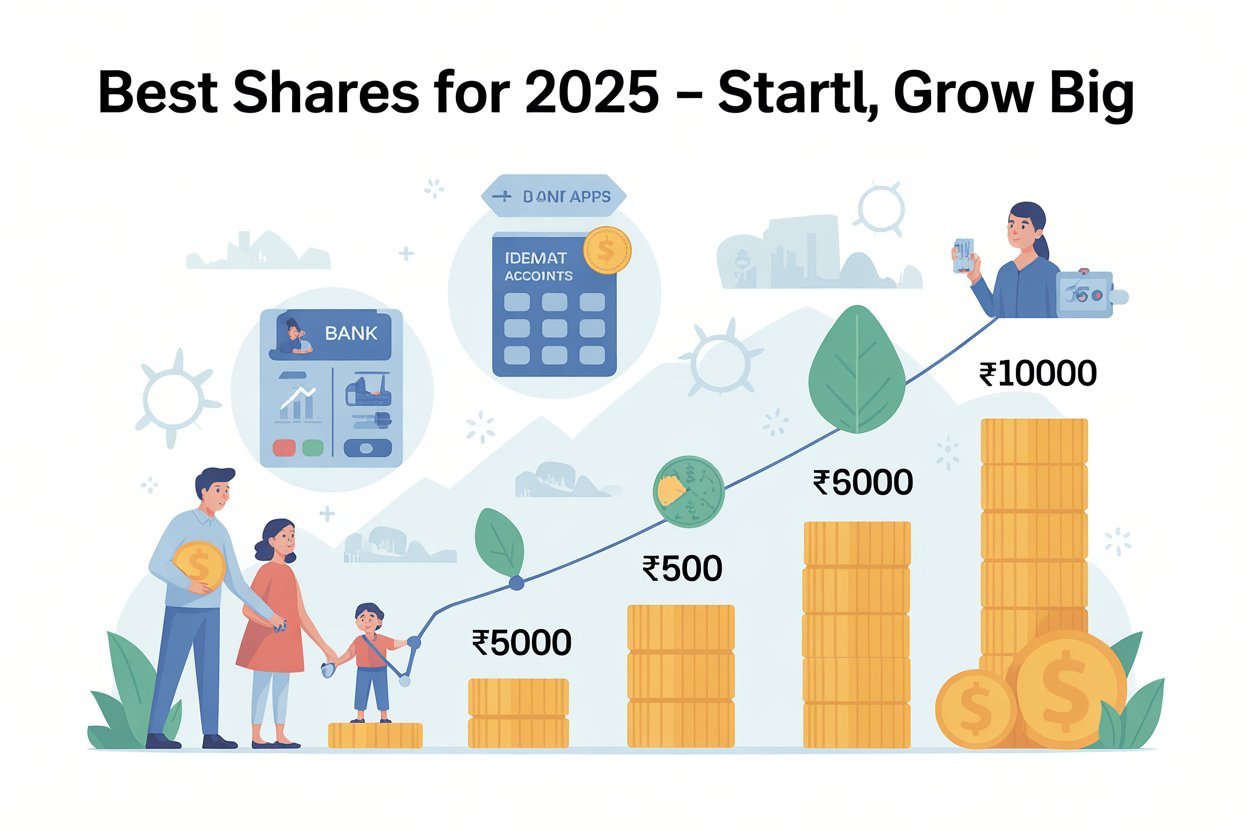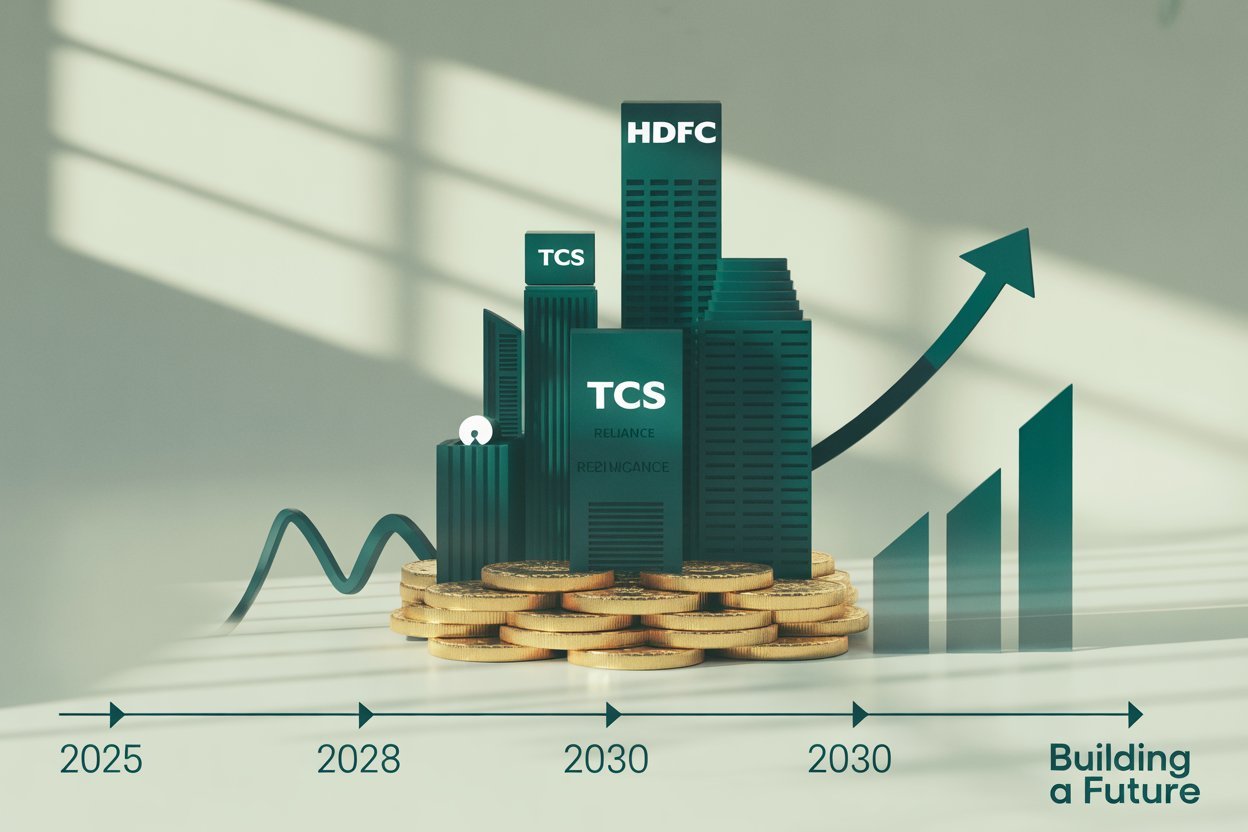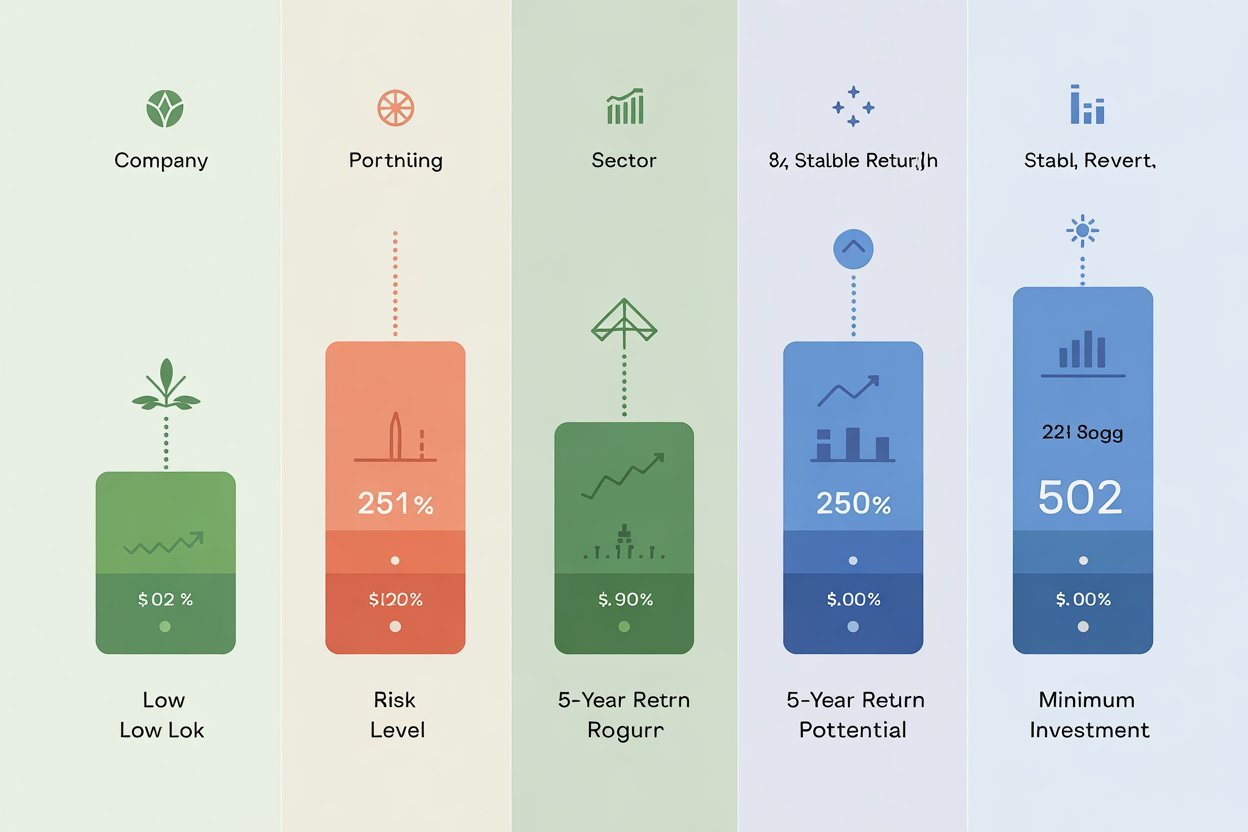Top 5 Best Shares to Invest in 2025 for Long Term with Low Risk
Top 5 Best Shares to Invest in for the next 5–10 years call for stable, well‐established companies across different sectors. For example, large-cap blue-chip stocks often top analysts’ lists – Tickertape’s mid-2025 ranking shows Reliance Industries and HDFC Bank as the #1 and #2 largest companies (with share prices ~₹1,392 and ₹2,005 respectively). This reflects their huge market caps and relative stability. In this guide, we profile five such low-risk, long-term picks (across energy/retail, banking, IT, FMCG, telecom) that even small investors (₹10–15K lump sum, ₹500–1,500 monthly) can buy. We explain how to invest step by step, and list the pros and cons of each stock.

Step-by-Step: How to Invest in Stocks
Learn how to buy shares: first open a Demat (trading) account, then research and place orders. Beginners should follow a simple process:
- Open a Demat/Trading Account: Choose a reliable broker and complete the KYC process to link your bank (you’ll need this to transfer funds).
- Login and Research: Use the broker’s website or mobile app to browse stocks and study their basics (business model, performance, news).
- Fund Your Account: Deposit money from your bank so it’s available for trading. (Most brokers let you start with any amount, even ~₹100.)
- Place a Buy Order: When you decide on a stock, enter how many shares to buy and at what price (market or limit order). The broker matches you with a seller and executes the trade. Once filled, the shares are credited to your Demat account.
TIP: You can invest either lump sum (e.g. ₹10,000–15,000 at once) or via a SIP (Systematic Investment Plan) of ₹500–1,500 each month. SIP investing is often safer for novices: it “averages” out market swings and is lower risk than one-time investing. For example, SIPs give “gradual exposure” to stocks and avoid the need to time the market. In contrast, a lump sum invests all at once (higher short-term volatility). Both methods build wealth over time; choosing one depends on your comfort with market ups and downs.

Top 5 Best Shares to Invest in 2025
1. Reliance Industries Ltd. (Energy, Retail & Telecom)
Overview: Reliance (NSE: RELIANCE) is India’s largest private company. It spans oil refining/petrochemicals, retail stores, telecom (Jio), and is rapidly expanding into green energy (solar, hydrogen) and digital services. This diversification and scale make it a flagship long-term pick. For example, analysts note that Reliance’s “push into green energy and digital platforms could be a defining long-term growth engine”. Indeed, Reliance keeps reinventing its portfolio. The share price (~₹1,392 as of Jul 2025) reflects its leadership position.
- Pros: Market leader in key industries; very cash-rich and debt-free. The business is diversified (oil-to-retail-to-tech), so growth in one area can offset another. Reliance offers exposure to India’s energy transition (new green energy projects). In FY2024 it invested heavily in solar and hydrogen, which analysts expect to drive future profits. Its telecom arm (Jio) remains the fastest-growing, and retail/consumer businesses provide steady cash flow. Many view Reliance as a “textbook” long-term stock, having achieved a 5-year return of ~28% (per ET) through consistent execution.
- Cons: As a huge company, Reliance’s growth is naturally slower than a small startup. The stock is also tied to commodity cycles: weakness in oil prices or a sharp market downturn can drag it down. In fact, Reliance’s share is down nearly 30% from its 2022 high, which some investors see as valuation risk (though others see it as a buying opportunity). Regulatory risks (e.g. petrol prices, environmental rules) can also affect its refining/mktg business. Entry into new ventures (like telecom and retail) means Reliance must continually invest, which can cap profit margins.
Minimum Investment: At ~₹1,392/share, ₹10,000 would buy 7 shares. ₹15,000 would buy ~10 shares. A ₹1,000 monthly SIP could accumulate ~0.72 shares/month (so ~8 shares a year). Even these small amounts get you ownership in India’s largest company.
2. HDFC Bank Ltd. (Banking/Finance)
Overview: HDFC Bank (NSE: HDFCBANK) is India’s biggest private-sector bank, known for safe growth and innovation. It merged with HDFC Ltd (home loans) in 2023 to create an even stronger franchise. Its network, deposit base (high CASA ratio), and loan book are very large. Analysts highlight its disciplined growth and low non-performing loans (NPAs) versus peers. As of mid-2025, HDFC Bank trades around ₹2,005.
- Pros: Strong legacy of steady growth and conservative lending. The bank maintains high capital reserves (CAR ~18–19%) and historically high ROE (~20%). It offers diverse loans (retail, home, corporate) and is leading in digital banking services. The merger with HDFC Ltd brings in a major home-loan portfolio, boosting future growth and customer base. HDFC Bank pays reliable dividends (though modest yield ~0.5%) and is widely followed by analysts for stability.
- Cons: In the short term, HDFC Bank has been slowing credit growth to manage its balance sheet. For example, in FY2025 it deliberately limited advances to ~6–7% growth (from ~15–17% earlier) to control its credit-deposit ratio. Its core home-loan book grew just ~7% (vs industry ~9%) as management chose higher loan rates over volume. This means earnings growth is temporarily muted. Also, like any bank, HDFC is sensitive to economic cycles: a slowdown could raise defaults. Its current valuation (P/E ~21×) is not cheap, so much of the long-term strength may already be priced in.
Minimum Investment: At ~₹2,005/share, ₹10,000 buys just 4–5 shares. ₹15,000 buys ~7–8 shares. With ₹1,000/month, you’d add ~0.5 shares each month. Note that even 5 shares will grow value over years through compounding.

3. Tata Consultancy Services Ltd. (IT Services)
Overview: TCS (NSE: TCS) is India’s largest IT services company, providing software and consulting to global clients. It has an unparalleled track record: very high margins, a net cash balance sheet, and strong client relationships. TCS was a compounding growth machine for decades. As of July 2025 it trades around ₹3,136.
- Pros: Market dominance in IT and digital services. TCS consistently earns high ROE (~51%) with virtually no debt. It has been a champion dividend payer (though yield 1.5%), and its large size means it can invest in new tech (AI, cloud) without financial strain. Many analysts consider it a “textbook” long-term pick for portfolios, given its stability and earnings history. Over 5 years it has delivered strong returns (>40%).
- Cons: Recent years have brought headwinds. The IT sector fell hard in 2024–25, and TCS’s stock is down ~21% in 2025 so far. Analysts caution that large IT firms are no longer guaranteed “buy-and-hold” winners without oversight. Demand from Western clients is soft, and there is intense price competition. In mid-2025, brokers warned that tech spending cuts have hurt fundamentals. Thus, future growth is not as certain as in the past. If global budgets shrink or if new technology cycles weaken, TCS earnings could slow. In summary, the main risks are cyclical downturns and competition in the IT sector.
Minimum Investment: At ~₹3,136/share, ₹10,000 buys only 3 shares. ₹15,000 buys 4–5 shares. A ₹1,500 monthly SIP would buy ~0.48 shares each month (roughly 6 shares a year). Because the share price is high, small investors will build a position more slowly.
4. ITC Ltd. (FMCG, Tobacco & Hotels)
Overview: ITC (NSE: ITC) is a diversified FMCG conglomerate. Its core is cigarettes and branded consumer goods (foods, personal care), with additional businesses in hotels, paper, and agribusiness. ITC is known for high margins, strong cash flow, and very generous dividends (yield ~4%). The stock trades around ₹409 – quite affordable for small investors.
- Pros: Stable, recession-resistant products. Tobacco (cigarettes) dominates ITC’s profits and has long-lasting brand loyalty; FMCG brands (Aashirvaad, Sunfeast, etc.) are market leaders in their niches. The company is debt-free and has one of India’s highest ROEs (~57%). Its diversified portfolio means it isn’t tied to a single sector cycle. Over decades, ITC has delivered steady growth and raised dividends regularly. Analysts note that its “consistent dividend payer” status and improving margins make it attractive for income-focused investors. ITC also maintains an extremely strong balance sheet.
- Cons: Growth has been sluggish recently. In Q4 FY2024, ITC reported just ~2% revenue growth and a 1.3% drop in net profit, as cigarette volume growth plateaued. Higher taxation and regulatory pressures on tobacco are constant risks. Its diversification into hotels and paper yields lower returns, and management has planned to spin off its hotel chain to focus on FMCG. In short, ITC’s sales are growing slowly, so investors rely on dividends. If macro consumer spending falters, even FMCG sales could slow. Regulatory changes (e.g., higher sin taxes) can hit profits. Overall, ITC is a low-pace, cash-cow investment – safe, but not a high-growth stock.
Minimum Investment: At ~₹409/share, ₹10,000 buys ~24 shares. ₹15,000 buys ~36 shares. Even a ₹500 monthly SIP buys ~1.2 shares (so ~14 shares/year). This makes ITC very accessible – you can build a position quickly with small money.
5. Bharti Airtel Ltd. (Telecom)
Overview: Bharti Airtel (NSE: BHARTIARTL) is one of India’s leading telecom operators (along with Jio). It offers mobile, broadband and DTH TV services domestically, and is expanding 5G. Airtel has rebounded strongly: as of July 2025 its share price is ~₹1,938, near record highs thanks to a national telecom revival.
- Pros: Large, diversified telecom player with growing 5G rollout. Airtel has consistently gained market share and recently hit new peaks as investors anticipate higher revenues from data and broadband. Its ROE (~25%) is healthy for telecom. Airtel also operates in several African countries through its subsidiary, offering growth overseas. Many lists of stable stocks (bluechips) include Airtel due to its scale – e.g. it ranks among the top bluechip stocks. If India’s economy grows and data usage rises, Airtel is well positioned to profit.
- Cons: High debt. Airtel’s parent and promoter (Bharti Telecom) has taken on enormous debt – around ₹40,000 crore at the end of FY2025 – mostly to buy its partner’s stake. Consolidated with Airtel’s own borrowings (~₹1.77 lakh crore including dues), this leaves the company highly leveraged. Ongoing debt servicing limits free cash flow. Airtel has repeatedly appealed to the government to swap some dues for equity to ease this burden. In short, a large chunk of earnings goes to interest, which makes growth plans riskier. Other risks: the telecom market is fiercely competitive (price wars), regulatory changes (spectrum costs, licences), and profit can be volatile. If data price war intensifies, margins could shrink.
Minimum Investment: At ~₹1,938/share, ₹10,000 buys ~5 shares. ₹15,000 buys ~7–8 shares. A ₹1,500 monthly SIP adds ~0.77 shares each month (about 9 shares/year). Even with its higher price, smaller investors can gradually build a stake via periodic buys.

How to Buy These Stocks
With your broker account set up, simply search each company’s ticker (RELIANCE, HDFCBANK, etc.) and place buy orders as above. You must buy whole shares, so you may need to round the number of shares to an integer (brokers do not sell fractional shares in India). If you can afford only ₹500–₹1,000 a month, consider a “stock SIP” (many brokers offer SIP plans for stocks) or invest in a diversified mutual fund/ETF that holds these shares.
Disclaimer: All stock investments carry risk. The above information is drawn from market analyses and is for educational purposes. Past performance is no guarantee of future results. Please do your research and consider your risk tolerance before investing.
Sources: Expert reports and market data on top stock picks, as well as financial news outlets. These inform the above company profiles and guidance.
Still confused where to begin?
Bookmark this guide, follow a SIP plan, and revisit your investments every 6 months. Let your money work for you—smart investing starts with simple steps.